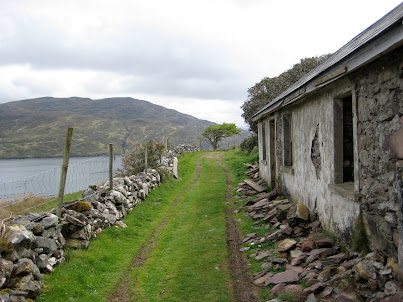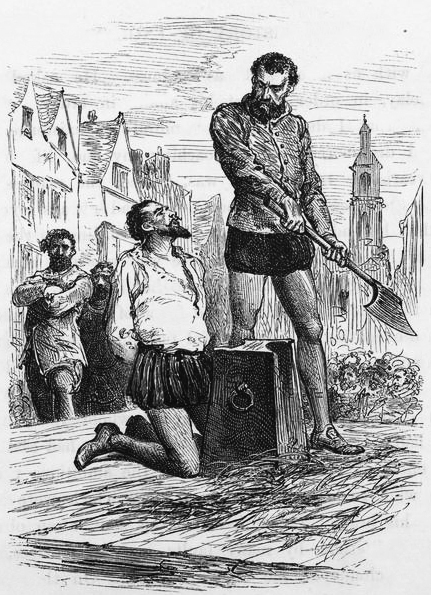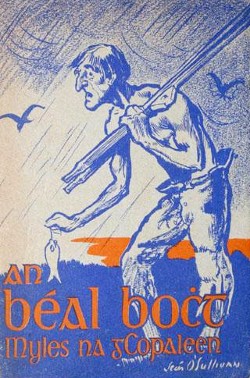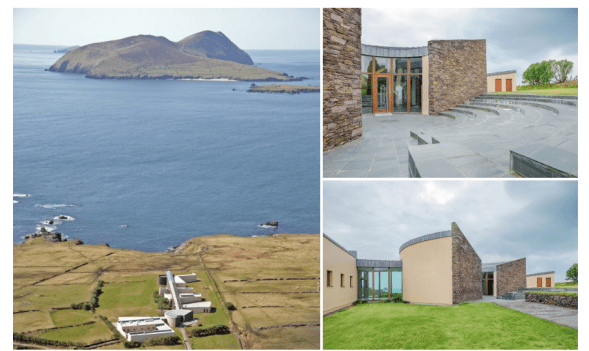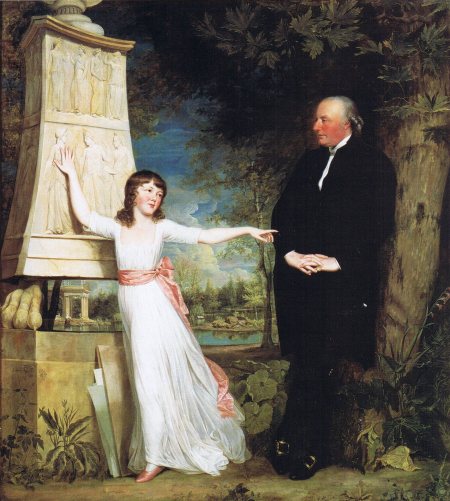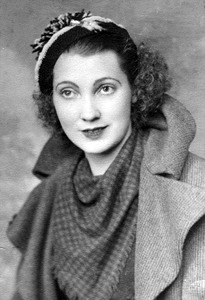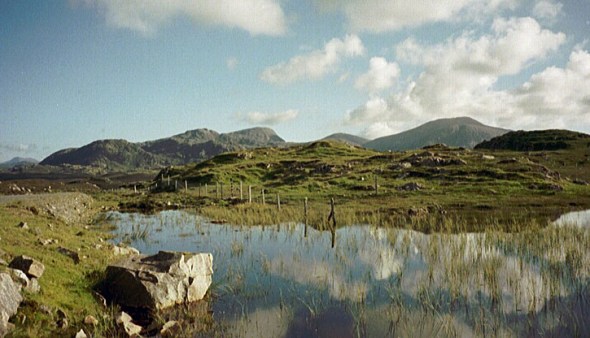Evacuation Day
Posted: March 17, 2022 Filed under: Boston, Ireland, Irish traditional music, New England Leave a commentToday is Evacuation Day in Boston, the day the British finally quit the city, giving up on the siege. Conveniently, it falls on Saint Patrick’s Day, so it’s Brits Out all around.
“Had Sir William Howe fortified the hills round Boston, he could not have been disgracefully driven from it,” wrote his replacement Sir Henry Clinton.
I thought this was interesting in this plaguey time:
Once the British fleet sailed away, the Americans moved to reclaim Boston and Charlestown. At first, they thought that the British were still on Bunker Hill, but it turned out that the British had left dummies in place. Due to the risk of smallpox, at first only men picked for their prior exposure to the disease entered Boston under the command of Artemas Ward. More of the colonial army entered on March 20, 1776, once the risk of disease was judged low.
How about Howard Pyle’s painting of Bunker Hill? (I can hear a Bostonian voice correcting me: “you mean Breed’s Hill?)
Can’t have been a fun time for British troops, half of whom were probably Irish recruits anyway. And what of the Dublin born Crean Brush, who met a sad fate for his Loyalism?
While imprisoned in Boston, Brush was denied privileges. He consoled himself with alcohol.
Wittgenstein on Dublin architecture
Posted: September 23, 2021 Filed under: Ireland Leave a comment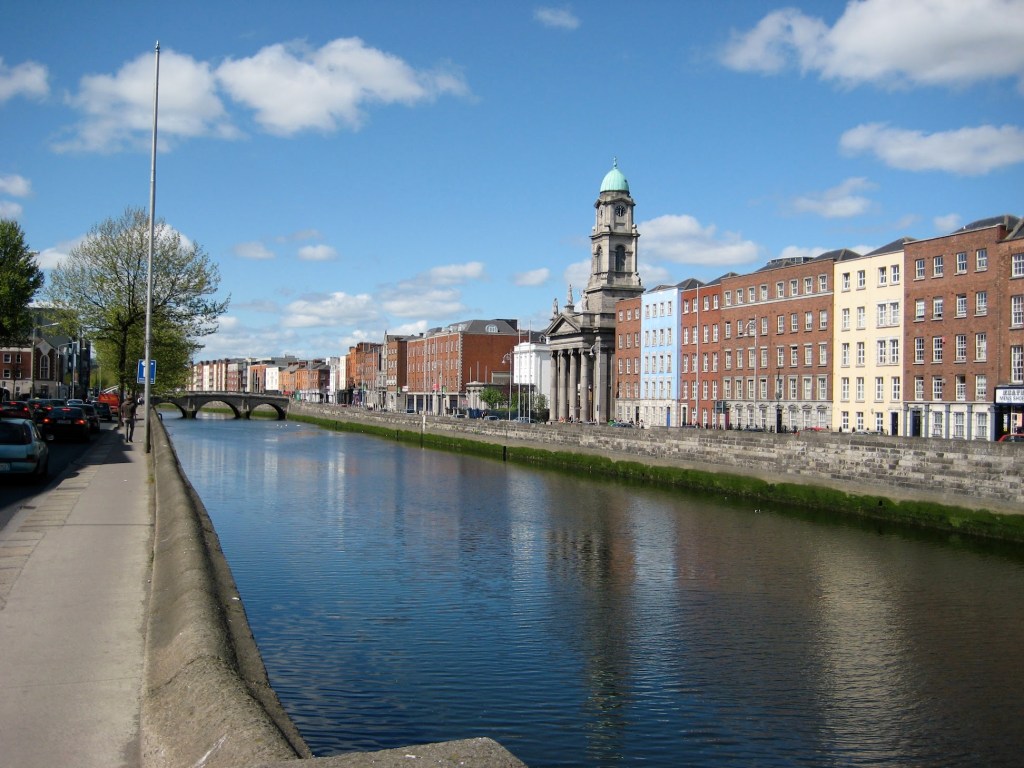
Of Dublin’s Georgian architecture, the streetscapes and squares of the city, he said: “The people who built these houses had the good taste to know that they had nothing very important to say; and therefore they did not attempt to express anything”. One thinks of the final sentence of the Tractatus, “what we cannot speak about we must pass over in silence.”
Got that from “Wittgenstein in Ireland: An Account of His Various Visits from 1934 to 1949” by George Hetherington in Irish University Review. Also of note:

Ludwig Wittgenstein
Posted: September 21, 2021 Filed under: crazy, Ireland, language Leave a commentBorn in Vienna to a very wealthy family, his father was a friend of Andrew Carnegie and had a near monopoly on steel in the Austro-Hungarian empire. Three of his four brothers would commit suicide, the fourth would lose an arm in World War I but still manage to become a concert pianist using only his left hand. His sister Margaret was a patient of Sigmund Freud’s and would later be painted by Klimt.
Ludwig went to the same elementary school as Adolf Hitler. There’s no clear evidence they met, although they were only two grades apart and it is possible but by no means agreed upon that the two as boys appear in the same school picture.
After studying in Berlin Ludwig worked on designing plane propellers with jet engines, he got a patent on one, but became frustrated. He spent some time “experimenting with kites at the Kite-Flying Upper Atmosphere Station near Glossop in Derbyshire.” He went to Cambridge in the UK where he pestered Bertrand Russell. John Maynard Keynes invited him to the join the Apostles, the gay-skewing secret society. Ludwig wasn’t that into it.
In 1913 his father died and Ludwig became one of the richest men in Europe. He moved to a remote village in Norway.
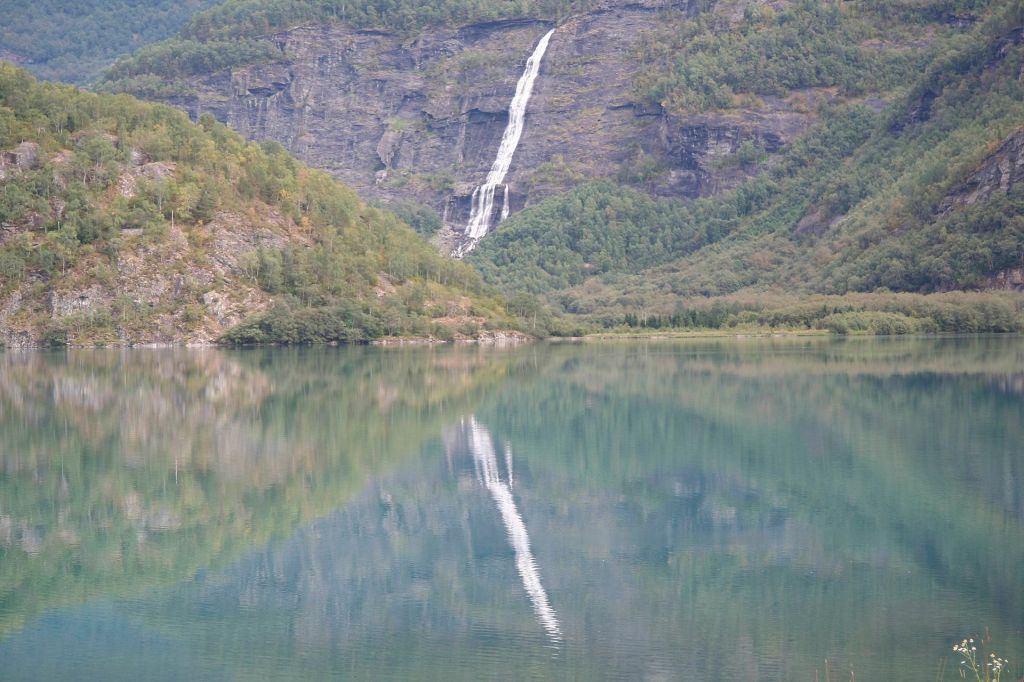
Eventually he found this place too busy.
When the Great War broke out, Ludwig volunteered for the Austro-Hungarian army, though he probably could’ve gotten out of it for health reasons. He served on a ship, was wounded in an explosion, became an officer directing artillery from no-man’s land, won several medals for bravery. He was there during the Brusilov offensive, where somewhere between 200,000 and 567,000 of his comrades were killed. He kept notes during the war:
The meaning of life, i.e. the meaning of the world, we can call God.
And connect with this the comparison of God to a father.
To pray is to think about the meaning of life.
In summer 1918 he took leave and went back to Vienna where his family had many house.
It was there in August 1918 that he completed the Tractatus, which he submitted with the title Der Satz (German: proposition, sentence, phrase, set, but also “leap”) to the publishers Jahoda and Siegel.
He went back to the front, this time to Italy, where he was captured and spent nine months in an Italian prison camp. After the war he gave away his huge inheritance to his siblings, and went to train to become an elementary school teacher. He became a teacher in a mountain village in Austria.
In 1921 the Tractatus was published. Here is the first sentence:
Die Welt ist alles, was der Fall ist.
Plug that into Google Translate, or use the standard translation, and you will get:
The world is everything that is the case.
Does that comma matter? Should it be:
The world is everything, that is the case
Or, in the Ogden translation, the first English version, approved by LW? Although he didn’t really speak English at the time?:
The world is all that is the case.
What about “case”? I have no background in German but looking up the word Fall it seems to also have connotations of drop, fall, instance.
That’s as far as I’ve gotten in the Tractatus. It doesn’t get easier from there:
The world is everything that is the case.[1]
1.1 The world is the totality of facts, not of things.
1.11 The world is determined by the facts, and by these being all the facts.
1.12 For the totality of facts determines both what is the case, and also all that is not the case.
1.13 The facts in logical space are the world.
1.2 The world divides into facts.
1.21 Any one can either be the case or not be the case, and everything else remain the same.
The decimal figures as numbers of the separate propositions indicate the logical importance of the propositions, the emphasis laid upon them in my exposition. The propositions n.1, n.2, n.3, etc., are comments on proposition No. n; the propositions n.m1, n.m2, etc., are comments on the proposition
Here’s my source. I have not decompressed all 75 pages.
This book will perhaps only be understood by those who have themselves already thought the thoughts which are expressed in it—or similar thoughts. It is therefore not a text-book. Its object would be attained if there were one person who read it with understanding and to whom it afforded pleasure.
As LW himself says.
After several years as an apparently terrifying rural elementary school teacher Ludwig hit a slow-witted kid on the head so hard he collapsed. In trouble, Ludwig resigned his position. He worked for a while as a gardener at a monastery. He designed a house in Vienna:
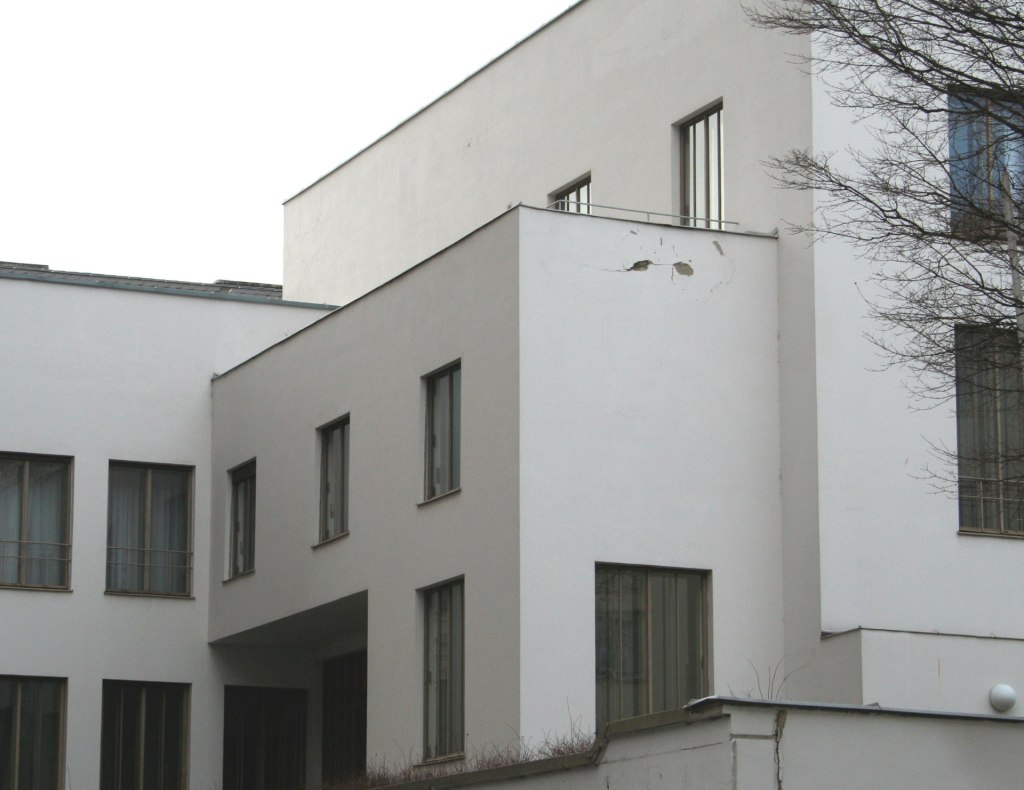
It took him a year to design the door handles, and another to design the radiators
He made some long confessions to friends, about things like white lies. He went back to Cambridge for awhile. He would relax by watching Westerns in the front row of the movie theater. Invited by the President of Ireland, Eamon De Valera, himself a former math teacher, to come over there, he did. He went back to the UK and during World War II he worked in a hospital.
He started working at Guy’s shortly afterwards as a dispensary porter, delivering drugs from the pharmacy to the wards where he apparently advised the patients not to take them.
After the war there was another Irish period, along Killary:
The nearest shop/post office was 10 miles away. He had to do his own housework and saw nobody except Tom Mulkerrins, who brought him his milk and kept him supplied with turf and conversation. He used the kitchen table mostly to work on, writing his aphoristic sentences on slips of paper and taking great pains to arrange them in the correct order. He did little cooking and almost all his food came out of tins. He spent hours watching seabirds and talking to them in German. The Mortimers, who were his next nearest neighbours, thought he was mad, perhaps because he wanted them to shoot their dog, whose barking disturbed him.
(source on that).
Realizing in 2012 I took a walk along Killary Harbour (it’s a fjord) not far from where he was holed up, it looks like this:
You can walk seven miles without seeing a person, easy. It’s along Killary Harbour too that Martin McDonough set The Beauty Queen of Leenane, a masterpiece of comic cruelty. I’d be curious what Wittgenstein thought of that play.
Ludwig took a trip to the USA, he went back to the UK, he was diagnosed with prostrate cancer, he died in 1951.
Just trying to wrap my head around the basic facts of this guy’s deal, prompted by this New Statesman article on the 100th of the Tractatus.
Say what you will, this guy was something!
The Tale of Mac Do Thó’s Pig
Posted: January 17, 2021 Filed under: Ireland Leave a comment
You can read it for yourself.
In the assessment of medievalist Nora Chadwick, “the tale is told with brilliant narrative power”: its terseness, humour and laconic brevity is reminiscent of the best of the Icelandic sagas.[62] The dialogue is particularly masterly in its “understatement and crisp repartee”, with “the utmost condensation and economy” in its choice of words. “[I]n the few remarks made by Mac Da Thó to his visitors, all his previous train of thought, all his cunning and address, are suggested in a few brief words intended by him to hide his true designs from his guests, while suggesting to ourselves his hidden intention.”
Maybe. In my reading it’s sorta like a Three Stooges episode but more violent? “a prankster amuses himself by screwing with guests at a barbecue,” might be the logline.
In “an imitable passage of compressed humour”, Mac Da Thó promises the dog to both parties, then feigns ignorance when both arrive on the same day. During the bragging contest, the heroes of the Ulaid are not merely shamed, but are made to look ridiculous. Hyperbole is used to humorous effect when Conall flings the head of Ánluan at his opponent Cet. Thurneysen notes that in the Harley 5280 manuscript “the mutual slaying of the guests” is referred to as “‘performing a good drinking round'” (so-imól) – a “somewhat coarse joke” that was revised or omitted in the other manuscripts because apparently the copyists did not understand it.
Nora Chadwick:
What I like about the story is the cauldrons:
There were seven doors in that hall, and seven passages through it, and seven hearths in it, and seven cauldrons, and an ox and a salted pig in each cauldron. Every man who came along the passage used to thrust the flesh-fork into a cauldron, and whatever he brought out at the first catch was his portion. If he did not obtain anything at the first attempt he did not have another.
Kind of a claw game/stew. There should be a restaurant that does this. After the pandemic, maybe.
Latitudes and attitudes
Posted: January 8, 2021 Filed under: Boston, Ireland, New England Leave a commentsomehow this map of Dublin swam into my ken, maybe on Twitter or something. I was struck by how the shape of Dublin’s harbor is similar to that of Boston’s. I’ve had three chances to visit Dublin, and I never put this together:
Tried to get those at roughly the same scale, with help from Zaia Design’s Two Maps:

Both east-facing harbors. Dublin’s a little smoother, makes sense, it’s older*, more time to smooth it down.
Dalkey, in vibe, is kind of like Hingham, too. Is Winthrop like Howth? I don’t know enough about the vibes of either Winthrop or Howth to report. There was a girl from Winthrop at a nerd camp I attended one summer. I remember her talking about the difficulty of going back and forth to the school she attended in Cambridge, but that’s about it, it’s neither here nor there when it comes to comparative geography, although maybe there was some girl in Howth at the exact same time with the exact same problem.
If there’s a Dublin equivalent of Hull, I bet that’s interesting, but it looks like in the south portion of Dublin harbor there are no crooked fingers of that nature.
Boston is at a latitude about 42.36 N. Dublin’s at 53,74, farther north, even north of Montreal (45.50) and even north of St. Johns, Newfoundland (47.56). The reason why Dublin’s climate is more temperate than that of Montreal has to do with, I believe, the gulf stream bringing warm air across the Atlantic. In very southern Ireland I visited a town that had some palm trees, I forget which town that was, it was over twenty years ago. I could probably find out but I’m not going to bother.
As for latitudes, Los Angeles is at 34.05, comparable to Baghdad (33.31). You might think weather-wise it might be aligned with Mediterranean cities, Barcelona for example, but Barca is further north (41.38). Paris is at 48.85 N. Tokyo is a close latitude cousin to LA, at 35.68 N. Interestingly, in the southern hemisphere, several major cities with attractive weather are in a similar range:
Melbourne: 37.85 S
Sydney: 33.86 S
Cape Town: 33.92 S
Buenos Aires 34.06 S.
In that same band N:
San Francisco: 37 N
Athens: 37 N
Las Vegas: 36 N
Tokyo, Osaka, Kyoto: 35 N
“Somebody out there must’ve compared cities by latitude before me,” I thought, and sure enough, here is “174 World Cities by latitude: Things Line Up In Surprising Ways” from a website about the business of travel.
Crazy that Chicago and Barcelona are at the same latitude. Both great, but quite different vibes (and climates. And food tastes).
* kidding?
Bloomsday
Posted: June 16, 2020 Filed under: Ireland Leave a comment
Today. Bloom sees a walking advertisement for his former employer:
A procession of whitesmocked men marched slowly towards him along the gutter, scarlet sashes across their boards. Bargains. Like that priest they are this morning: we have sinned: we have suffered. He read the scarlet letters on their five tall white hats: H. E. L. Y. S. Wisdom Hely’s. Y lagging behind drew a chunk of bread from under his foreboard, crammed it into his mouth and munched as he walked. Our staple food. Three bob a day, walking along the gutters, street after street. Just keep skin and bone together, bread and skilly. They are not Boyl: no: M’Glade’s men. Doesn’t bring in any business either. I suggested to him about a transparent show cart with two smart girls sitting inside writing letters, copybooks, envelopes, blotting paper. I bet that would have caught on. Smart girls writing something catch the eye at once. Everyone dying to know what she’s writing.
Rude!
Posted: February 21, 2019 Filed under: Ireland Leave a comment
We usually have very fine commenters here at HelyTimes but occasionally some bore tries to ruin the party. This one regards my post where I suggested Ireland should take in two million refugees. (Seems fair enough to me, the rest of the world took in two million Irish).
Hey, as long as we’re starting a conversation.
Messed up hoodie they’re selling in Germany
Posted: November 10, 2018 Filed under: Ireland, London Leave a comment
saw that when I went to read a Der Spiegel interview with Jeremy Corbyn:

More close than is comfortable to a kind of snobbish anti-Semitism is the most upper classy thing about Jeremy Corbyn, I wonder if it’s some kind of weird signal in the English language of codes.
I mean the ironic style that gives us our famously impenetrable sense of humour (which we will need now the rest of the world is laughing at us). The perfidious style that allows us to hide behind masks and has made England superb at producing brilliant actors for the West End but hopeless at producing practical politicians for Westminster. The teasing style of speaking in codes that benighted foreigners can never understand, however well they speak English. The cliquey style that treats England as a club, not a country, and allowed Jeremy Corbyn to say that Jews cannot “understand English irony”, however long their ancestors have lived here.
from this Guardian piece by Nick Cohen. More:
The deferential style that allowed one Etonian to lead the Remain campaign and another to lead the Leave campaign and for the English to not even see why that was wrong. The life’s-a-game-you-shouldn’t-take-too-seriously style that inspired Cameron to say he holds “no grudges” against Boris Johnson now the match is over and the covers back on the pitch. The gentleman amateur style that convinced Cameron he could treat a momentous decision like an Oxford essay crisis and charm the electorate into agreeing with him in a couple of weeks, as if voters were a sherry-soaked don who could be won round with a few clever asides. The effortlessly superior style that never makes the effort to ask what the hell the English have to feel superior about. The gutless, dilettantish and fatally flippant style that has dominated England for so long and failed it so completely. The time for its funeral has long passed.
The ancient and modern codes and secret languages of the British Isles are an inexhaustible subject.

Feels in a way like Corbyn’s take on Brexit is “we must respect the voters’ stupidity.” If he sold this take out, and presented Labour as the un-Brexit, would that be good politically? If you’re over there sound off in the comments.
Chalk and cheese
Posted: June 25, 2018 Filed under: Ireland, words Leave a comment
The tour guide at Dublin’s Farmleigh House used the expression “chalk and cheese.”
I took it to mean something like “apples and oranges,” “two things you can’t compare.”
Or maybe it’s more like, “two things that are very different but which you could mistake for each other.”
Went looking for real life examples and found this fine, civil exchange on a Linkedin story about Lagos and Tokyo, whether they are chalk and cheese:

Interesting point about Tokyo’s 23 wards! Sometimes I wonder if Los Angeles needs way localer governance.
Smerwick harbor
Posted: June 4, 2018 Filed under: Ireland Leave a comment
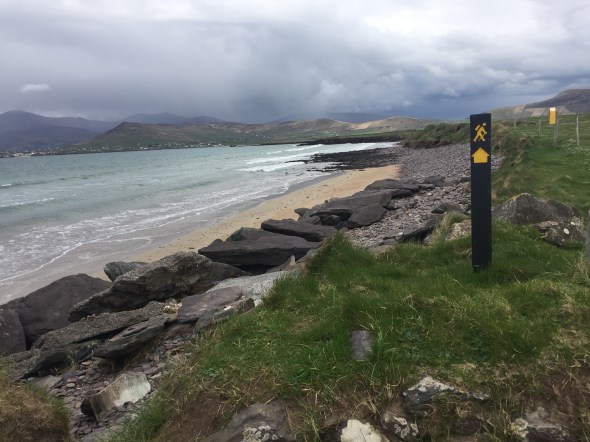
Poke into the history of just about any place in Ireland and sooner or later you’ll find an event of such violence and sorrow as to be almost ridiculous. Take Smerwick harbor. Here in 1580 six hundred luckless Italian and Spanish soldiers got massacred:
According to Grey de Wilton’s account, contained in a despatch to Elizabeth I of England dated 11 November 1580, he rejected an approach made by the besieged Spanish and Italian forces to agree terms of a conditional surrender in which they would cede the fort and leave. Lord Grey de Wilton claimed that he insisted that they surrender without preconditions and put themselves at his mercy, and that he subsequently rejected a request for a ceasefire. An agreement (according to Grey de Wilton) was finally made for an unconditional surrender the next morning, with hostages being taken by English forces to ensure compliance. The following morning, an English force entered the fort to secure and guard armaments and supplies. Grey de Wilton’s account in his despatch says “Then put I in certain bands, who straight fell to execution. There were six hundred slain.“
Shannon Luxton on Wiki took this photo of the massacre site:

According to the folklore of the area, the execution of the captives took two days,
Ask yourself — would you rather be beheaded day one, or day two?
with many of the captives being beheaded in a field known locally in Irish as Gort a Ghearradh(the Field of the Cutting); their bodies later being thrown into the sea. The veracity of these accounts was long disputed, until a local field known as Gort na gCeann (the Field of the Heads) was investigated by 21st-century archaeologists and found to be full of 16th-century skulls.
The Field of the Cutting. Jeezus, Ireland. And how about this monument to the heads?
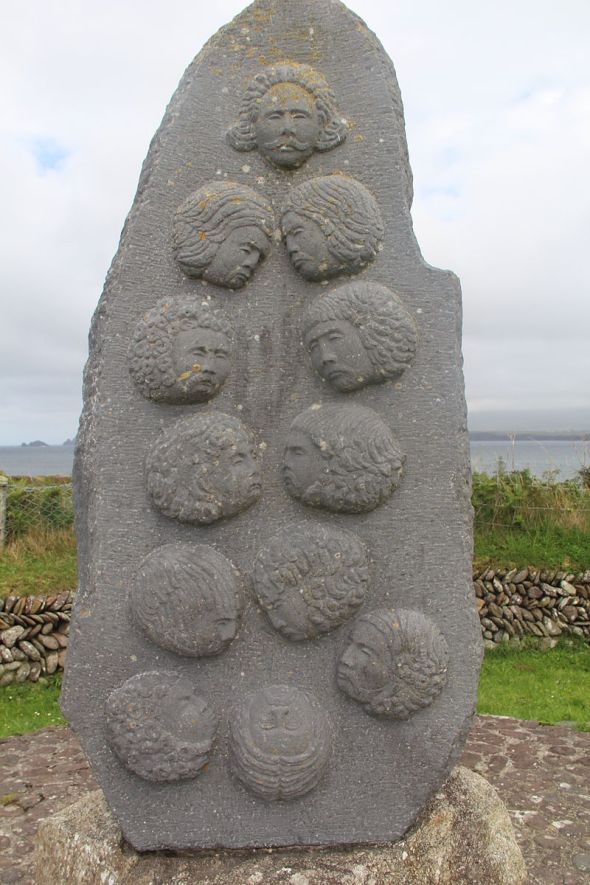
Dáibhí Ó Bruadair on Wiki
Even for the time the Smerwick mass beheading was considered a bit much. Sir Walter Raleigh was in on it. Later his involvement was used against him.
Behead and ye shall be beheaded: eventually it was his turn:
Raleigh was beheaded in the Old Palace Yard at the Palace of Westminster on 29 October 1618. “Let us dispatch”, he said to his executioner. “At this hour my ague comes upon me. I would not have my enemies think I quaked from fear.” After he was allowed to see the axe that would be used to behead him, he mused: “This is a sharp Medicine, but it is a Physician for all diseases and miseries.” According to biographers, Raleigh’s last words (as he lay ready for the axe to fall) were: “Strike, man, strike!”
Some four hundred thirty-eight years post Smerwick, the Spanish, Italians and Irish are on the verge of an England-less European Union. That my friends is called winning the long game.
Great Blasket Island
Posted: May 27, 2018 Filed under: architecture, Ireland Leave a comment
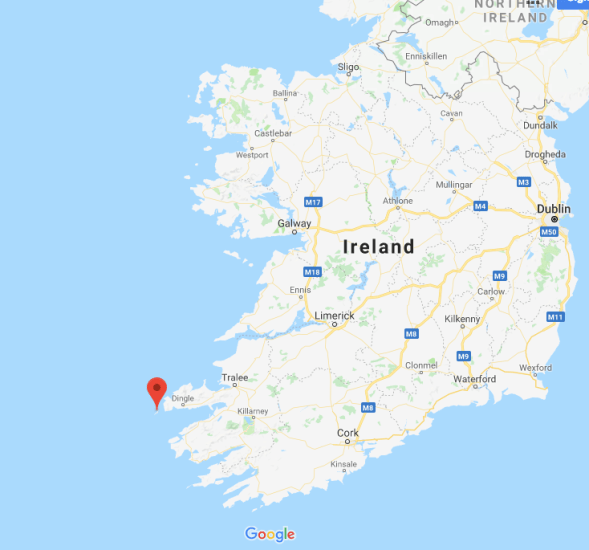
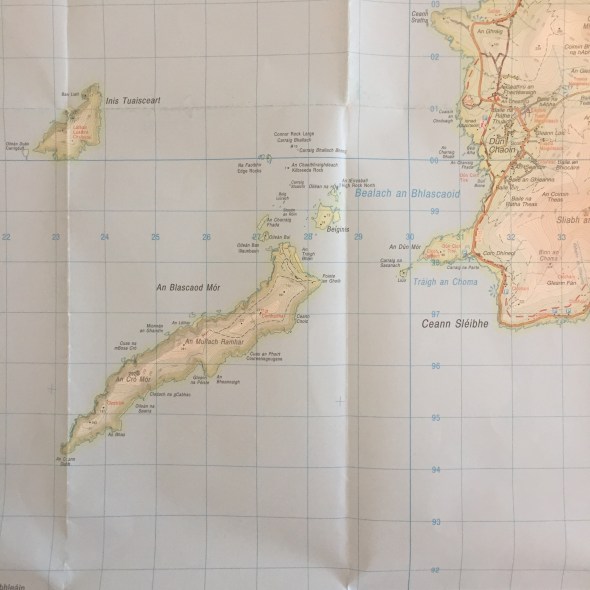

Not easy to get there:
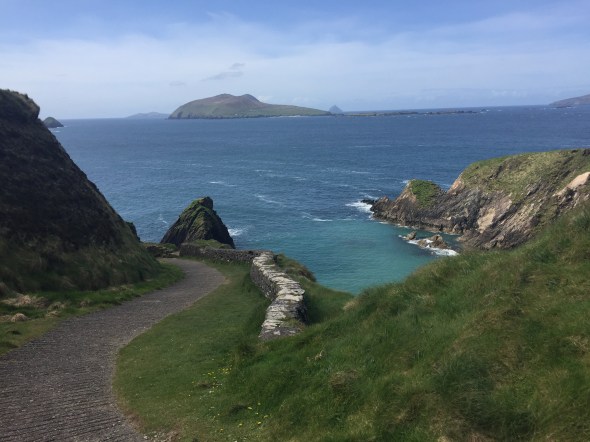
Lucky weather on this particular day.

What we might call in the USA a ghost town. The last inhabitants were evacuated in 1953:

In 1907 Norwegian linguist Carl Marstander went there to learn Irish from this local:
Tomás Ó Chriomhthain, who later wrote a book about his life there.
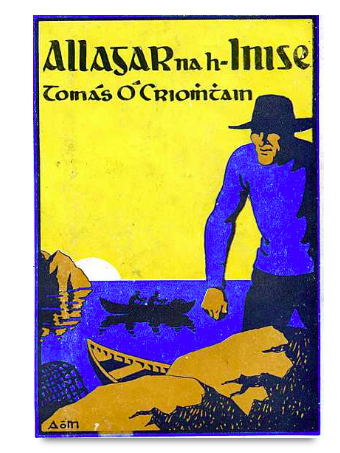
source
Some other islanders wrote, or dictated, their own tales of their hard and primitive lives on this island:
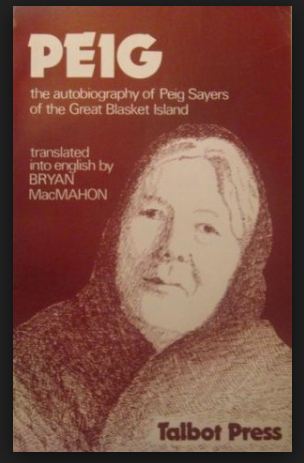
As a girl Peig Sayers was supposed to go join a friend in America, but the friend had an accident and couldn’t send the money. She gave birth to eleven children. Five died.
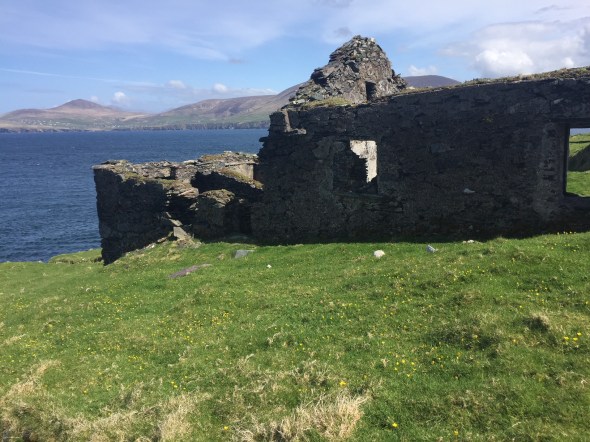
Peig’s book was (I’m told, by the excellent tour guide) forced on generations of Irish schoolchildren. In 1941 this genre of rural Irish poverty literature was parodied by Flann O’Brien / Brian O’Nolan / Myles na gCopaleen:
An Béal Bocht is set in Corca Dhorcha, (Corkadoragha, Corkadorkey), a remote region of Ireland where it never stops raining and everyone lives in desperate poverty (and always will) while talking in “the learned smooth Gaelic”.
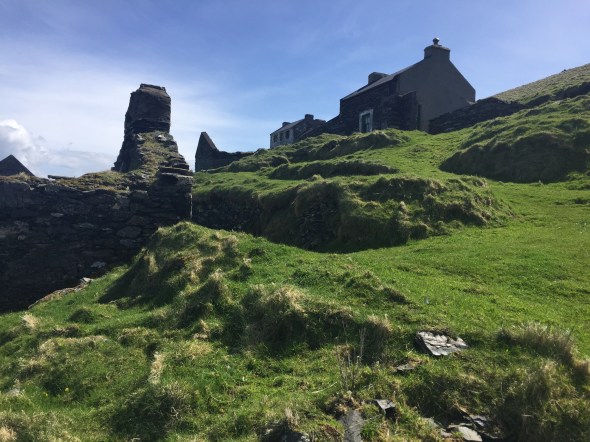 Blasket life does seem rough.
Blasket life does seem rough.
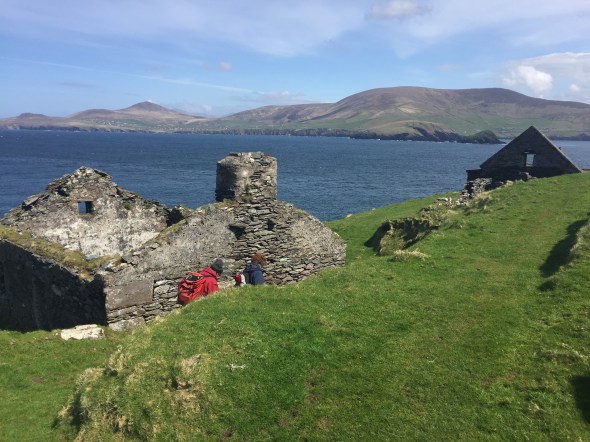
This was my second visit, and both times I’ve been blown away by the Blasket Center / Ionad Blaiscoid Mhór.
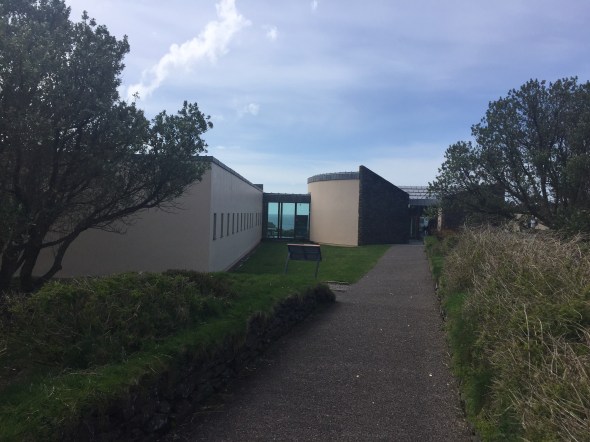
The architecture and design and use of landscape on this building is just very cool:
Here’s it from afar:

Couldn’t find online who the architect was, so I emailed them, and they wrote back and told me:
The architect of the centre was Ciaran O’Connor, who is the State architect nowadays.
State architect. Cool.

Really impressed with the Irish OPW. They take care of their treasures, Ireland.
Let’s wish him well!
Stars of the National Gallery of Ireland
Posted: May 26, 2018 Filed under: art history, Ireland 3 Comments
source
“Pwease Adam? One bite? You’ll like it I promise!”
The Temptation of Adam, by James Barry.
Look grandfather, I am but a nymph!
Lady Caroline Crichton and her grandpa?
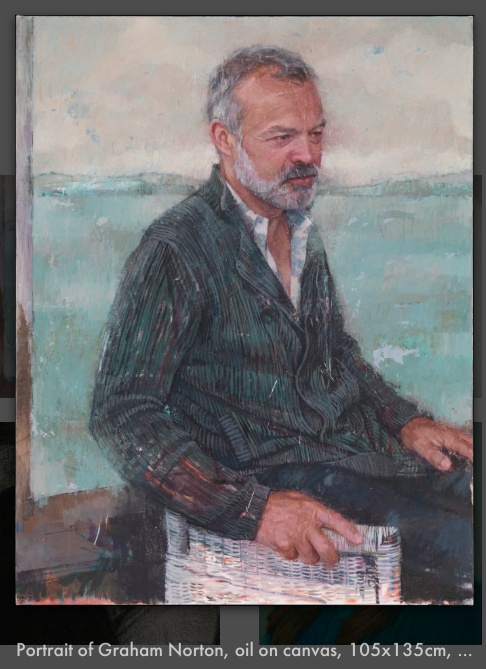
Gareth Reid, Graham Norton (from Gareth Reid’s website)
In 1992, Norton’s stand-up comedy drag act as a tea-towel clad Mother Teresa of Calcutta in the Edinburgh Festival Fringe made the press when Scottish Television’s religious affairs department mistakenly thought he represented the real Mother Teresa.
This one by Paul Henry, A Connemara Village, is under some serious copyright I guess.
Robert Ballagh’s portrait of Neil Brown “communicates the resolute character for which he was known.” I’ll say! Copyright plus reproductions don’t do it justice. Worth seeing if you’re in Dublin.
Also good:
John Kindness, Gay Byrne

The Liffey Swim by Jack Yeats (W. B’s brother) won Ireland’s first Olympic medal, a silver in 1924 in the category Painting. (Jean Jacoby took gold).
Irish Abortion
Posted: May 23, 2018 Filed under: Ireland 2 Comments
The Irish are having a referendum on whether to repeal the 8th amendment to their constitution, which bans abortion.

Struck by the bluntness of the campaigning. 
Feel the experience of growing up around Catholic anti-abortion people helps explain things that seem incomprehensible to some liberal pals, like how people could vote for Roy Moore (or Donald Trump).
People hate abortion protesters. ‘They’re so shrill and awful.’ But they think babies are being murdered. What are they supposed to be (saying)? ‘Well, hmmm … that’s not cool.
(Don’t ask who said that.)
Is anyone convincing anyone on this one?

Not easy to find “new” arguments on the abortion issue but Irish novelist Sally Rooney made a point I hadn’t heard stated so cleanly before:
Yes. Pregnancy, entered into willingly, is an act of generosity, a commitment to share the resources of life with another incipient being. Such generosity is in no other circumstances required by law. No matter how much you need a kidney donation, the law will not force another person to give you one. Consent, in the form of a donor card, is required even to remove organs from a dead body. If the foetus is a person, it is a person with a vastly expanded set of legal rights, rights available to no other class of citizen: the foetus may make free, non-consensual use of another living person’s uterus and blood supply, and cause permanent, unwanted changes to another person’s body. In the relationship between foetus and woman, the woman is granted fewer rights than a corpse. But it’s possible that the ban on abortion has less to do with the rights of the unborn child than with the threat to social order represented by women in control of their reproductive lives.
(Don’t like how they spell fetus as foetus. One of many upsetting aspects.)
Anyway, let’s see who wins! The vote goes down Friday.
Fairy Fort
Posted: May 23, 2018 Filed under: Ireland Leave a comment

My assistant shows us the height of the walls.
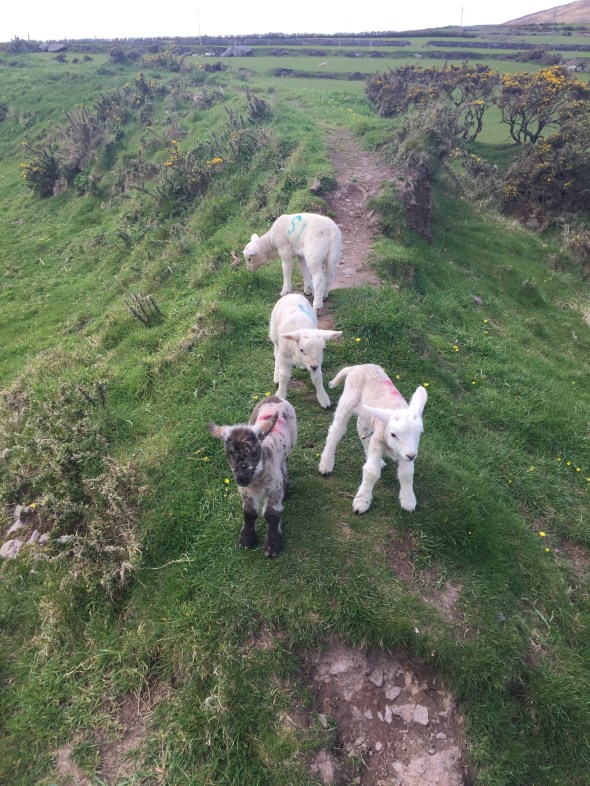
This part of the fort was too well defended to explore.
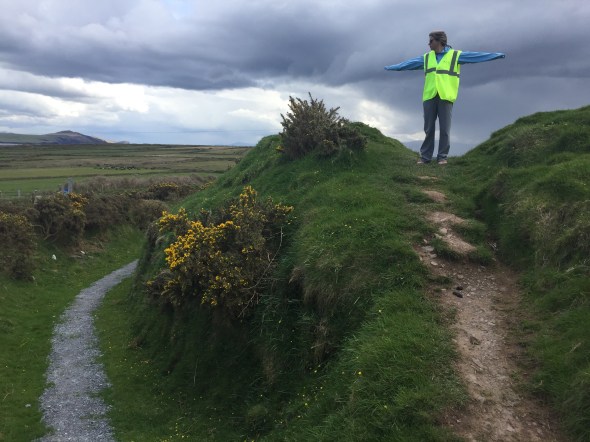
Note the width of the walls. This suggests fairies of significant size. Not inconceivable that these fairies stood as high as five or even six apples.
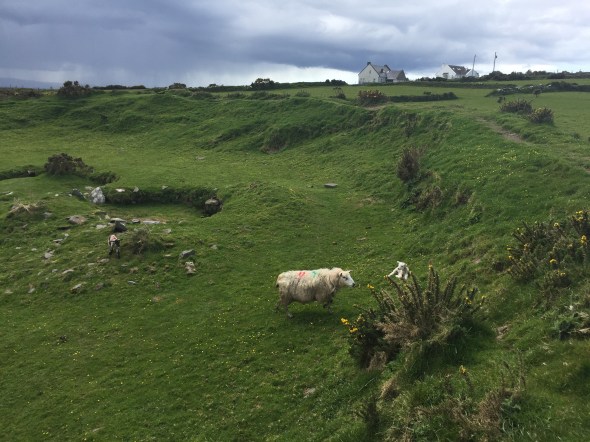
The inhabitants of the fort wallow in safety.

Many forts like this can be found in Ireland, sometimes billed as “Iron Age forts.” When was the Iron Age?
The Iron Age is taken to end, also by convention, with the beginning of the historiographical record. This usually does not represent a clear break in the archaeological record; for the Ancient Near East the establishment of the Achaemenid Empire c. 550 BC (considered historical by virtue of the record by Herodotus) is usually taken as a cut-off date, in Central and Western Europe the Roman conquests of the 1st century BC. The Germanic Iron Age of Scandinavia is taken to end c. AD 800, with the beginning Viking Age.
The distant and mysterious past, in other words. 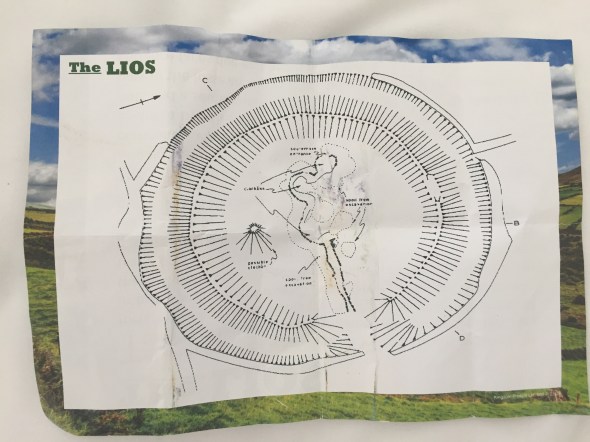
Insight into the “crazed Wisconsin” period of Irish history.
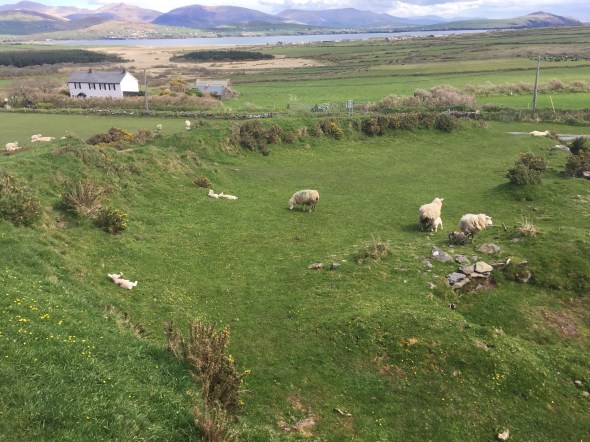
Queens Elizabeth
Posted: May 21, 2018 Filed under: beheadings, Ireland, war, women Leave a commentO’Byrne’s corpse was butchered and for months the head and quarters hung on pike staffs on the wall over Dublin Castle drawbridge. Several months later the pickled head was presented to the council secretary at London by an English adventurer, who was disappointed to find that the head-silver due on O’Byrne* had already been paid in Ireland. The queen was angered that, “the head of such a base Robin Hood was brought solemnly into England“.
Read enough Irish history and you gain a grudging respect for Queen Elizabeth I. She’s always delivering withering remarks and savage putdowns to people giving her bad news.
In 1603, Elizabeth had seemed a foolish old woman, as men looked expectantly to a Stuart king. By 1630, when Stuart kings had proved rather a disappointment, she had become the paragon of all princely virtues.
-
Christopher Haigh,The Golden Age of Queen Elizabeth I—Myth or Reality? Awake! magazine, 2010, 1/10 pp. 19-22.
At this remove, who can say if Elizabeth was a foolish old woman or one of history’s canniest power players, but I’m team power player. She managed to survive rebellions, armadas, assassination attempts, plagues, you name it!
Just surviving as a queen is tough.

The (current) Queen did not seem that into the wedding. The Crown may have fooled us into thinking the Queen is more woke than she is.
* was reading about O’Byrne after seeing convo on Tom Ricks’ twitter about the origin of “firebrand”
Mysterious Antiquities of Ireland
Posted: May 13, 2018 Filed under: Ireland Leave a comment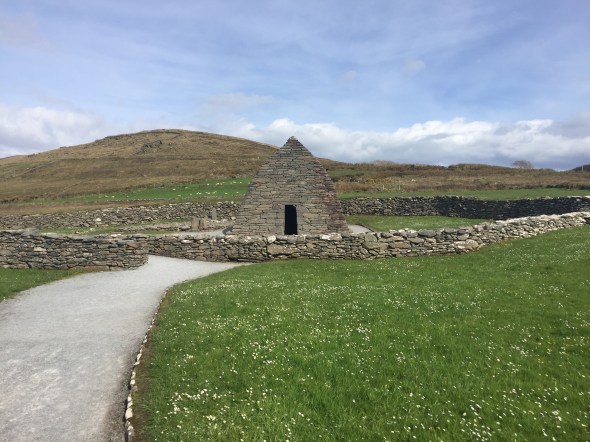
Way out there in the Dingle peninsula they’ve got the Gallarus / Gallros / Ghallrois:
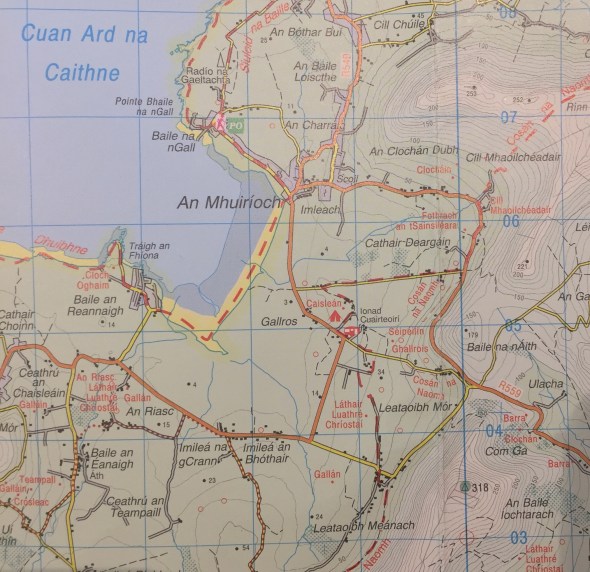
What is it?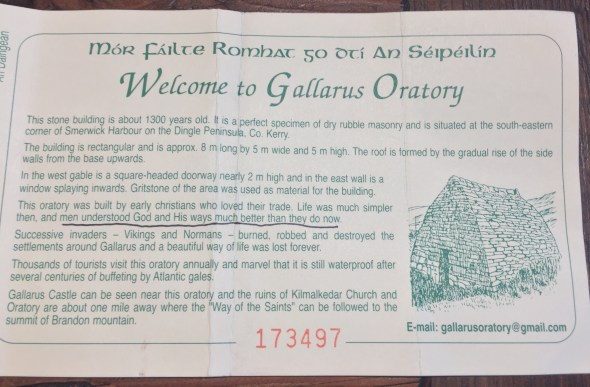
The oratory was built by early christians who loved their trade. Life was much simpler then, and men understood God and His ways much better than they do now
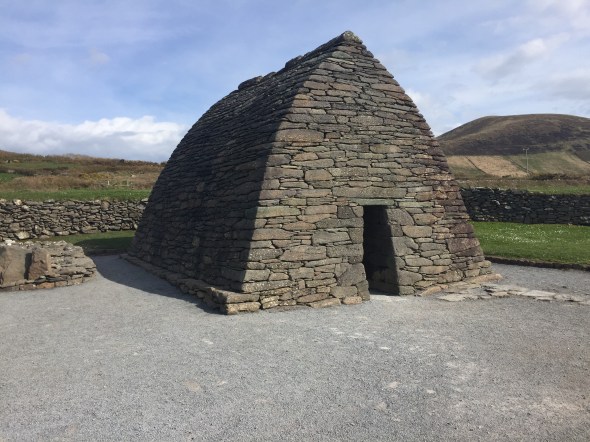
The construction is impressive. 
Wikipedia only adds to the mystery:
Dates and uses
Minor trial cuttings carried out at Gallarus in November 1970 yielded no finds or evidence of features or activity which might shed light on the period of construction and use of the oratory.
An early Irish stone church
Antiquarian Charles Smith[7] is the originator of the claim that the building is an early Irish stone church although no historical information is available prior to 1756 regarding its use.
Gotcha. It more or less “appears” in written history in 1756? This area, while beautiful, is remote. People still speak Irish there now, can only imagine what it was like in 1756
A Romanesque Church
In 1970, archaeologist Peter Harbison argued that the oratory might have been built as late as the 12th century for a number of reasons, mainly because the east window has a rounded top made of two carved stones (not a true arch).
Hmm! Arch evidence.
A private funerary chapel
Harbison also produced some evidence pointing to a later date and a different use: a letter by English traveller Richard Pococke who visited the oratory in 1758, two years after it was discovered by Charles Smith:[10] “Near this building they show a grave with a head at the cross of it and call it the tomb of the Giant; the tradition is that Griffith More was buried there, & as they call’d [it] a chapel, so probably it was built by him or his family at their burial place.”
A tomb for giants? I love this!
A shelter for pilgrims
In 1994 and 1995, Peter Harbison gave up the hypothesis of a 12th-century church and claimed that the placename Gallarus meant “the house or shelter of foreigner(s)” (Gall Aras), the said “foreigner(s)” being pilgrims from outside the peninsula.[12] However, this does not accord with lexicologist Padraig O Siochfhradha’s translation of the name as “rocky headland” (Gall-iorrus).
I remember the word aras in Irish because Bus Aras is where you catch the bus. The bus house.
Gall:

A steam bath? The English house? The walnut place?
Killer location, anyway.

French tourists
Posted: May 4, 2018 Filed under: Ireland Leave a comment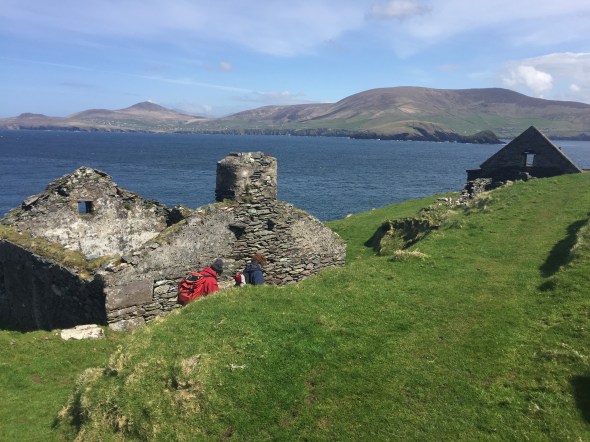
thought they were ruining my photo but now I see they were essential.
Wars Of The Irish Kings
Posted: April 3, 2018 Filed under: Ireland Leave a comment
In fact, land in pre-twelfth century Ireland had little political value. Although there were rich plains, it was not a farming culture but a decentralized grazing one in which wealth was measured in cattle. There were no cities, and the kingdoms, which rarely had roads or clearly defined boundaries, were separated by a dense forests and bogs, which were more of a deterrent to travel (or easy military movement) than the mountains. A reading of the sometimes-cryptic early annals suggests and endless series of battles and cattle raids. To be glib, early medieval Ireland sounds like a somewhat crazed Wisconsin, in which every dairy farm is an armed at perpetual war with its neighbors, and every farmer claims he is a king.
Some tite illustrations in the book:

For a dip into Irish history, you can’t top:

The illustrations go a long way towards telling the story.
It’s not all bad. 
Edward McGuire’s portrait of Seamus Heaney.
Stewball
Posted: March 28, 2018 Filed under: animals, Ireland Leave a comment
Samuel Sidney [The Book of the Horse, 1875, repr. ed. Bonanza Books, 1985] stated Skewball “…won a great number of plates and prizes in England, and one famous match in Ireland.” The Irish turf callendar says he won six races worth £508 in 1752, when he was eleven years old, and was the top earning runner of that year in Ireland. The match became the subject of a ballad, Skewball, which has endured, in varying forms, to the present day.
The match celebrated by the ballad is listed in Pond’s Racing Calendar of 1752. It was held at the Curragh in Kildare, Ireland, on Saturday, March 28, with each participant putting up 300 guineas. Arthur Marvin (also Marvyn, or Mervin) owned Skewball, who carried 8st. 7lb. His opponent was “Sir Ralph Gore’s grey mare,” carrying the heavier weight of 9 st. Skewball was a gelding, which explains why he was still running at age eleven; although it was not uncommon for horses to run to ages 9 or 10 during that period, successful stallions were usually retired from the turf to commence their stud careers. He won the 4 mile race in 7 minutes and 51 seconds.
(source)
Whatever just noting that it’s the 266nd anniversary of a run by a horse in a race that people are still singing about.

A skewbald horse. Karakal’s own work on Wiki
They don’t seem to run many four mile horse races anymore. Some history on these “real stayers.”

Sir Ralph Gore, owner of the grey mare, was born at Belle Isle castle.

During the Battle of Lauffeld on 2 July 1747 all his superior officers were killed or severely wounded, so command of the battalion fell to Gore, who performed so well, that on the following day he received the thanks of the British commander Prince William, Duke of Cumberland.
The Curragh:

photo by Eoghan888
(Remembering now that I stopped there once to visit the Irish National Stud)

Helytimes own photo
Leadbelly’s version:
and one more from Leadbelly:
Check out the bowties on The Hollies:
Mary Anne Trump
Posted: January 6, 2018 Filed under: America Since 1945, Ireland, Irish traditional music, mothers Leave a commentOne of our most popular posts is on Fred Trump, outrageous, villainous, smiling agent of chaos much like his son.

But we never really thought about Trump’s mother. Mothers should be off limits maybe? Even Trumps have mothers. A hasty misreading of this Kellyanne Conway quote:

Got us to look into it.
Stunned to find Trump’s mother was a Gaelic-speaking immigrant from a remote Scottish island.
Hailing from the Outer Hebrides
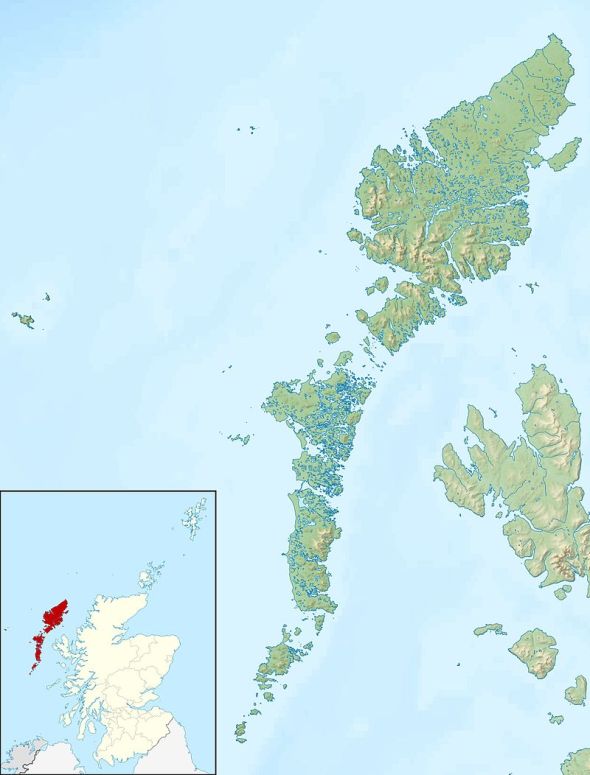
Mary Anne MacLeod was born in Tong, on Lewis in the Outer Hebrides of Scotland, United Kingdom, in a pebbledashcroft house numbered “5 Tong”

Tong
She was raised in a Scottish Gaelic-speaking household with her second language being English, which she learned at Tong school where it was reported she was a star pupil. Mary attended the school up until the eighth grade. Her father was a crofter, fisherman and compulsory officer (truancy officer). According to one profile, she was “brought up in an environment marked by isolation, privation and gloom.”
Wow. She’s pretty much from the Iron Islands.

You can see her interviewed in 1994 on Irish television, RTé, here. She has an interesting accent. She speaks of her love of Irish and Scottish music.

She claims Trump is meeting Steven Spielberg?


